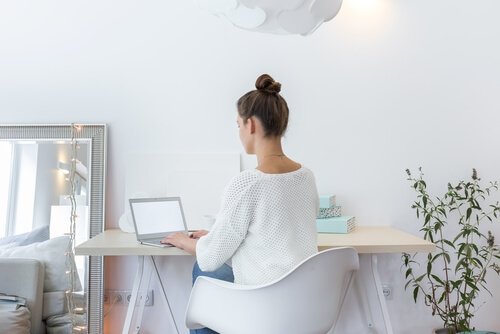What is a Minimalist Lifestyle?

Architect and writer John Pawson says that “minimalism, more than an architecture, is a way of life”. This is exactly how some people have come to understand minimalism. In this regard, they created a platform to teach about minimalist lifestyles.
The platform we’re referring to is called The Minimalists, where participants try to make sense of life. How? Well, for example, they generate alternatives for our material needs that are generated by advertising.
What is a minimalist lifestyle?
According to minimalists, today we live in an overly-stimulating world. In addition, many of these stimuli come from advertisements that want to make us buy more and more stuff. This means that they make us think we need more stuff in order to feel good about ourselves.
According to minimalist thinking, with each new purchase, we become heavier. That’s to say, our emotional plane becomes overloaded and we begin to lose our freedom as humans.

That’s why the creators of the minimalist lifestyle, Ryan Nicodemus and Fields Millburn, define this way of living as the tool that serves as a catalyst to get rid of excesses. Why should we do this? We should do this so that we can focus on what’s really important and the things that really lead to happiness, freedom, and fulfillment.
If you’re interested in the minimalist way of life, there are a series of characteristics that define it. They’re based on a single idea: eliminate material and artificial needs, put them in the background of our lives, and focus on ourselves.
Eliminate unnecessary things
Minimalists say that we should eliminate everything in our life that isn’t completely necessary. If you’ve been storing useless trinkets and memories, you should get rid of the stuff you don’t need. Empty that space so you can fill it with things that will actually improve your quality of life.
More traditional wisdom reminds us that attachment to material things makes us slaves. When we accumulate things, we waste our time cleaning and ordering those objects. That’s so much time wasted that we could have spent pursuing useful endeavors. For this reason, minimalists are happy to have empty drawers and cabinets. They eliminate things that they don’t have a use for.
“If you want to create something beautiful, you just have to do what’s necessary, nothing more.”
-Giorgio Armani-
Get rid of your attachment to things
Sometimes we get attached to our stuff. This is one of the reasons why we have such a hard time throwing things away. It’s true that our things are full of memories. However, minimalism isn’t afraid to remind us that, in reality, our memories exist in our minds and the people we shared them with, not in material things.
Minimalists agree that we have to project ourselves towards the future, not the past. Therefore, instead of being attached to our stuff, we should be attached to people, starting with ourselves.
Order and simplicity at home
These people also emphasize the importance of having an organized and neat home where simplicity is the dominant theme. Everything we own should have a specific use and a specific place t0 keep it. Keeping an object in the same place makes it easier to find, since you always know where it’ll be.
“There are times when the taste for simplicity has become an almost generalized feeling.”
-John Pawson-

Controlling your consumerism
Another important aspect of minimalism is controlling how and what we buy. We have to be careful with our purchases since we sometimes buy useless things.
Minimalists also believe that for everything that we bring into our home, another thing should leave in its place. If something you own is now useless to you, you should sell or donate it. Don’t let it sit around collecting dust in your home.
Digitization
Another idea that minimalists go for is digitization. They advocate using technology to create photo albums, invoices, letters, and tickets, among other things. For example, we can scan a photo into our computer or a memory drive and then throw the material object away.
Other minimalist options
There are other options that minimalists like to promote. As you can imagine, they all have the same idea of simplifying life and letting go of material possessions.
- Simplify technology. That is, don’t have a cell phone, music player, laptop, and a desktop computer… Try to combine everything in the least number of devices possible.
- Control the amount of information you consume. Since we’re exposed to a lot of stimuli throughout the day, it’s easy to lose focus on the things that really matter. Instead of being informed about what’s actually going on in the world, we become lost in consumerism.
- Select commitments. Don’t waste your time on dates and meetings that aren’t going to do anything for you. We have to use our time wisely and be more productive. In order to do that, sometimes we have to put our foot down and just say no.
- Accumulating experiences instead of objects is another main goal of this lifestyle.
- Finally, minimalists emphasize how important it is to control our minds and focus on what’s truly important while seeking emotional balance.
This is the minimalist lifestyle. Learning to live in the present, directing ourselves towards the future. Enjoying small experiences and accumulating only the most necessary possessions. Does this interest you?
Architect and writer John Pawson says that “minimalism, more than an architecture, is a way of life”. This is exactly how some people have come to understand minimalism. In this regard, they created a platform to teach about minimalist lifestyles.
The platform we’re referring to is called The Minimalists, where participants try to make sense of life. How? Well, for example, they generate alternatives for our material needs that are generated by advertising.
What is a minimalist lifestyle?
According to minimalists, today we live in an overly-stimulating world. In addition, many of these stimuli come from advertisements that want to make us buy more and more stuff. This means that they make us think we need more stuff in order to feel good about ourselves.
According to minimalist thinking, with each new purchase, we become heavier. That’s to say, our emotional plane becomes overloaded and we begin to lose our freedom as humans.

That’s why the creators of the minimalist lifestyle, Ryan Nicodemus and Fields Millburn, define this way of living as the tool that serves as a catalyst to get rid of excesses. Why should we do this? We should do this so that we can focus on what’s really important and the things that really lead to happiness, freedom, and fulfillment.
If you’re interested in the minimalist way of life, there are a series of characteristics that define it. They’re based on a single idea: eliminate material and artificial needs, put them in the background of our lives, and focus on ourselves.
Eliminate unnecessary things
Minimalists say that we should eliminate everything in our life that isn’t completely necessary. If you’ve been storing useless trinkets and memories, you should get rid of the stuff you don’t need. Empty that space so you can fill it with things that will actually improve your quality of life.
More traditional wisdom reminds us that attachment to material things makes us slaves. When we accumulate things, we waste our time cleaning and ordering those objects. That’s so much time wasted that we could have spent pursuing useful endeavors. For this reason, minimalists are happy to have empty drawers and cabinets. They eliminate things that they don’t have a use for.
“If you want to create something beautiful, you just have to do what’s necessary, nothing more.”
-Giorgio Armani-
Get rid of your attachment to things
Sometimes we get attached to our stuff. This is one of the reasons why we have such a hard time throwing things away. It’s true that our things are full of memories. However, minimalism isn’t afraid to remind us that, in reality, our memories exist in our minds and the people we shared them with, not in material things.
Minimalists agree that we have to project ourselves towards the future, not the past. Therefore, instead of being attached to our stuff, we should be attached to people, starting with ourselves.
Order and simplicity at home
These people also emphasize the importance of having an organized and neat home where simplicity is the dominant theme. Everything we own should have a specific use and a specific place t0 keep it. Keeping an object in the same place makes it easier to find, since you always know where it’ll be.
“There are times when the taste for simplicity has become an almost generalized feeling.”
-John Pawson-

Controlling your consumerism
Another important aspect of minimalism is controlling how and what we buy. We have to be careful with our purchases since we sometimes buy useless things.
Minimalists also believe that for everything that we bring into our home, another thing should leave in its place. If something you own is now useless to you, you should sell or donate it. Don’t let it sit around collecting dust in your home.
Digitization
Another idea that minimalists go for is digitization. They advocate using technology to create photo albums, invoices, letters, and tickets, among other things. For example, we can scan a photo into our computer or a memory drive and then throw the material object away.
Other minimalist options
There are other options that minimalists like to promote. As you can imagine, they all have the same idea of simplifying life and letting go of material possessions.
- Simplify technology. That is, don’t have a cell phone, music player, laptop, and a desktop computer… Try to combine everything in the least number of devices possible.
- Control the amount of information you consume. Since we’re exposed to a lot of stimuli throughout the day, it’s easy to lose focus on the things that really matter. Instead of being informed about what’s actually going on in the world, we become lost in consumerism.
- Select commitments. Don’t waste your time on dates and meetings that aren’t going to do anything for you. We have to use our time wisely and be more productive. In order to do that, sometimes we have to put our foot down and just say no.
- Accumulating experiences instead of objects is another main goal of this lifestyle.
- Finally, minimalists emphasize how important it is to control our minds and focus on what’s truly important while seeking emotional balance.
This is the minimalist lifestyle. Learning to live in the present, directing ourselves towards the future. Enjoying small experiences and accumulating only the most necessary possessions. Does this interest you?
All cited sources were thoroughly reviewed by our team to ensure their quality, reliability, currency, and validity. The bibliography of this article was considered reliable and of academic or scientific accuracy.
- González, G. L. (2017). Sobre continuidad, especificidad, minimalismo y símbolos. Algo más sobre el enfoque modular e internista. Ludus Vitalis, 12(22), 203-212.
- Ramos, J. (2019). Minimalismo. XinXii.
- Sólyom, A. (2018). Minimalismo vital: Simplicidad para una vida plena y con sentido. Integral: Vive mejor en un mundo mejor, (463), 52-57.
This text is provided for informational purposes only and does not replace consultation with a professional. If in doubt, consult your specialist.







